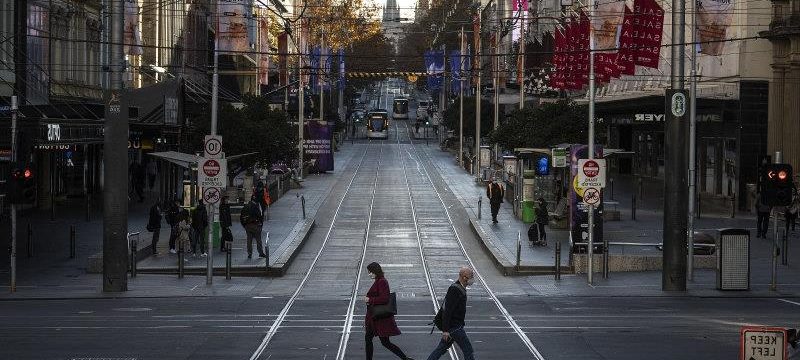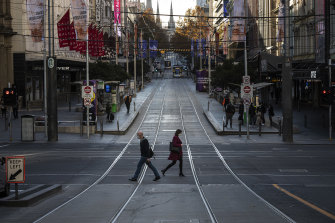For our free coronavirus pandemic coverage, learn more here.
After two weeks in hard lockdown, Melburnians have been allowed to venture out further again. While there are still COVID-19 infections that are of concern – particularly those linked to the Delta variant and the new unlinked cases in the city’s north – it appears the worst may be behind us.
The number of active COVID-19 cases has fallen for several days, as has the number of exposure sites and close contacts forced into home quarantine. It will be a welcome return to some normality to have the majority of businesses reopen and every student back at school. Parents are breathing a sigh of relief.
Melbourne’s city streets have been largely deserted during the lockdown.Credit:Getty Images
However, it would be wrong to call this an end of lockdown. At best, it’s an easing, with considerable restrictions remaining for at least another week, restrictions that will have a severe impact on many businesses and the mental health of many of people. Can we lock everyone down, again and again, until most of us are vaccinated?
Having, fingers crossed, got through the toughest period of restrictions, we must have a discussion about what lessons have been learnt. With there having been 22 breaches of hotel quarantine across Australia, and with at least six more months before a substantial number of people are vaccinated, it is probably only a matter of time before another outbreak occurs.
There are some noticeable areas that have vastly improved from last year. Contact tracing is the most obvious. Last year, the system was quickly overwhelmed. Methods of keeping track of cases were outdated and an overly centralised workforce had little local knowledge. Resources for COVID-19 testing have also been bulked up, allowing for peaks during this outbreak of more than 50,000. What is also now a given is that lockdowns need to be hard and fast. That was not the case last year, when it took weeks before the second lockdown was enforced with strict restrictions. By that time, the virus had already spread across the city.
But there is room for improvement. As Professor Brendan Crabb, the head of Melbourne’s Burnet Institute, said on ABC Radio on Wednesday, we need to obsess far more about mitigation rather than the binary discussion of yes and no when it comes to shutting down sectors in the community. What does that mean? Instead of schools merely waiting for the next orders to return to Zoom classes, he is advocating that far greater effort and thought be put into establishing the conditions that would enable students to stay in the classroom. Vaccinating teachers is essential, but there are other measures, including checking for poor ventilation and moving high-risk activities outside, that could turn closing schools into a last resort, instead of a first step.
There must also be a continuing focus on aged care homes, a vulnerable setting. The realisation that few private aged care workers and service providers had been vaccinated, despite them being high on the priority list, was a failure not just of the federal government, which oversees the sector. The nursing homes themselves must take some blame for leaving their residents at risk.
Lockdowns are a blunt instrument. As more is understood of how COVID-19 travels through a community, it is essential for governments to continue to tailor their response to the actual threat. Victorians have proven remarkably compliant in following tough restrictions, but this has come at an enormous cost to many people’s wellbeing and finances. A future lockdown is not inevitable, but it’s likely enough that the Andrews government should begin planning for it once this outbreak fully recedes. We have learnt much since the first lockdown, with those lessons decisive in limiting the spread this time around. If lockdown 5.0 were to happen, we need to ensure that it benefits from a renewed effort to lessen the impact on those worst affected.
Gay Alcorn sends an exclusive newsletter to subscribers each week. Sign up to receive her Note from the Editor.
Most Viewed in National
Source: Read Full Article

